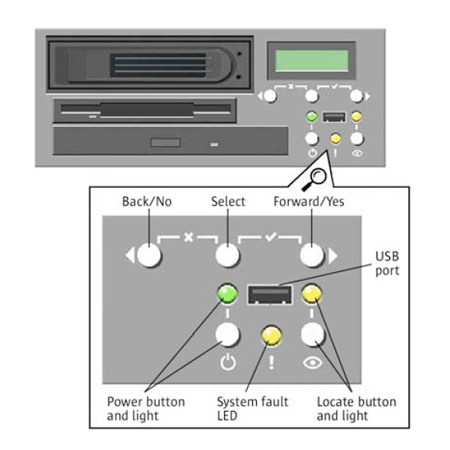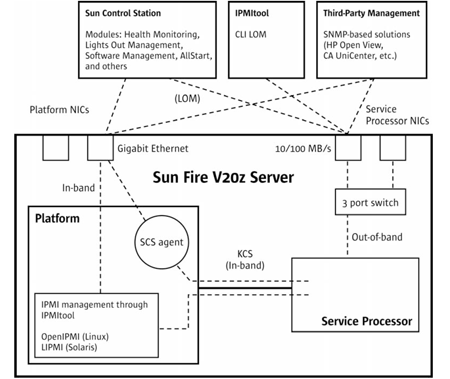Sun Fire V40z: Four Opterons in a 3U
by Kristopher Kubicki on February 22, 2005 12:05 AM EST- Posted in
- Systems
System Management: Another Linux Success
Sun easily separates themselves from whitebox manufacturers with their management capabilities. The fact that Sun chose an embedded Linux platform as the nerve center of their server really only proves to sweeten the pie.The MPC855T PowerPC – or Service Processor (SP) as it’s more commonly called in this analysis – is in fact an entire embedded Linux computer of its own. Even when plugging in one of the managed power supplies, the SP kicks on and boots up. All management of the system is handled through this minicomputer: the serial console, front console, BIOS, fan speeds and even power draw. Even when the machine is off, the SP allows us to manage the status of the system, even if it has crashed, remotely or locally. In a worst case scenario, the SP can actually be rebooted from a hard switch in the rear of the machine.
Fortunately, Sun provided us with another block diagram to explain the inner workings of the Service Processor.
Two 10/100 out-of-band Ethernet ports are routed via a dedicated three-port Ethernet switch solely to the Service Processor. This way, any management Ethernet can actually be daisy-chained to reduce the total number of cables in a rack. IPMI, SNMP or Sun Control Station can all route over this out-of-band (or in-band) network for server status and maintenance. The out-of-band network address of the Service Processor can actually be set via the console in the front of the server, or via DHCP (default). Of course, the traditional serial console is also available for those who need it.
Given the versatility, and since it’s always running, we can actually connect remotely to the SP via SSH and do things like update the BIOS, or perhaps just change some settings in it. This “Lights Out Management” approach is not a new concept, but Sun clearly has the most thorough implementation that we have yet to touch.

Overall, we were incredibly impressed with the thoroughness of Sun’s Service Processor. Anything short of forgetting the BIOS password or replacing hardware will ensure that the system stays up. Considering that most of the tools used inside the SP environment are free and/or open sourced, it only adds further to its desirability as clever administrators could very easily expand on the SP’s original functionality.











38 Comments
View All Comments
RyanVM - Tuesday, February 22, 2005 - link
Did anybody else find it confusing that the reviewed system had CG-stepping Opteron 850s and Kris brought up E4-stepping Opteron 852s on multiple occasions? What CPUs were actually in the system?SUOrangeman - Tuesday, February 22, 2005 - link
Last page, .."Sun has a speed **daemon** on their hands, ..."
Freudian slip, hehe? Nice read nonetheless.
-SUO
KristopherKubicki - Tuesday, February 22, 2005 - link
MrEMan: Mediaplex is just an advertising server. Some advertisers (like NewEgg) host their banners on Mediaplex so they don't destroy their bandwidth. Sometimes when an ad campaign is hitting too many impressions the Mediaplex tag will revert to a 2x2 or a 1x1 pixel so that they don't harm their click through rates. It has nothing to do with spyware or malware or adware.Kristopher
MrEMan - Tuesday, February 22, 2005 - link
Anandtech,What is with the 1/16" x 1/16" graphic (1280x1024 resolution on a 19" CRT monitor) for adfarm.mediaplex.com ?
Is it there with your permission or did someone hack your site?
If it is there with your permission, I must say I am surprised that you would put such stealth adware garbage links on your site.
jcourtney - Tuesday, February 22, 2005 - link
I'd love to see some benchmarks with Solaris instead of or vs. Linux for reference too. Nice read though as usual.ElFenix - Tuesday, February 22, 2005 - link
"particularly considering the fact that the V40z does not utilize any active cooling directly on their CPU heat sinks"whoa, proper spelling of heat sink!
now i'm going to harp on the fact that blowing air across a radiator with a fan is not active cooling. air conditioning is active cooling, turning on the ceiling fan is not.
=)
nice read
Hikari - Tuesday, February 22, 2005 - link
I wish I could see a comparison of this and that Quad Opteron HP server. I have the HP one budgeted for this year already... (we're also a Sun shop).I didn't see an option for 15k RPM drives though. I could put in like 5-146GB@15k RPM in the HP which was one reason I was leaning towards it.
lihoyin - Tuesday, February 22, 2005 - link
Looking forward for a comparsion with HP DL585 / DL 385, both are also Monsters!Sunner - Tuesday, February 22, 2005 - link
Googer, that's true, Sun basically just rebadges Newisys servers, the same is true of the V20Z, in fact IIRC you can actually find some Newisys marks left on the servers :)Anyway, Kris, any chance of a couple of benchmarks with a 2.6 based distro?
2.6 has, among other things, good NUMA support, something that would be nice to have when running a 4-way Opteron ;)
//Sunner
dougSF30 - Tuesday, February 22, 2005 - link
Another 250/850 typo on page 3: "Below, you can see one of the Opteron 250s is exposed from under the copper heat sink on the daughterboard."